|
Chapter 1
Change is in the Air
There was “change” in
the air - - - palpable, unmistakable, historical change. It permeated the very breath inhaled
by the infant born into the Ware household on November 15, 1714. On that cold winter’s day in
Gloucester County, Virginia, there was no way that young James Ware could have
possibly imagined how differently his world would look at the end of his life
from the way it did then – on his birthday.
In the years to come, James would find his identity changed in many ways. He would morph from being a colonist
in the New World to a “Patriot” in the United States of America. He would no longer embrace the
Episcopal religion of his forefathers but would become an ardent follower of the
new Baptist faith that arose out of the break with England. Perhaps most dramatic of all, James
would cease being a Virginian and would ultimately die in the new land he
adopted in the latter part of his life.
Many of his descendants would continue to call themselves “sons of
Virginia” but James Ware I would be buried in Kentucky – a vast, unsettled
wilderness that was virtually unheard of on this day of his birth.
There was also no way
that James could know that just one month after his November arrival, a baby
girl would be born in the same locale who was destined to become his wife and
helpmate during all those years of change.
Agnes Todd was born on the 20th of December 1714. Although there is not much
information concerning her family background, it is likely that her parents had
many connections with the Payne and Taylor families that came over from England
and settled in the tidewater area of Gloucester, Virginia. Thomas Todd, possibly one of her
relatives, was one of the earliest immigrants to America, and he had built a
large home called Toddsbury in the area where both James and Agnes were born. There were many Todd family members
in Gloucester County as well as descendants of Colonel James Taylor, who also
emigrated from England to Virginia at that time.
Future generations would see the Paynes, Taylors, Todds, and Wares marry
into each other’s families so often that by the mid-1700s their names would be
linked in ways that are visible in the following quote from a book titled
James Madison by Ralph Ketcham:
“On September 15, 1794, his
[James Madison’s] cousin Lucy
Taylor’s husband, the Reverend
Alexander Balmain of Winchester, pronounced the solemn words that began
forty-two years of devotion in marriage for James Madison and Dolley Payne
Todd.”
(Ref. 2376)
Notice the connection between the families mentioned above:
Lucy Taylor Balmain was
the sister of Elizabeth Taylor - the grandmother of Frances Toy Glassell
who married Josiah Ware, great grandson of James Ware and Agnes Todd
Ware.
(Ref. 2354, 2377)
Family Bible entry
(Ref. 621)

Transcription: “Our Great Grandmother’s
Grandfather James Ware Senior born Nov. 15, 1714
Agnes Todd wife of James Ware Senior was born Dec. 20, 1714”
There was speculation at
one time that the father of Agnes might be Dr. George Tod, who was educated in
Scotland,
(Ref. 625)
but with subsequent
findings giving him a birth date of 1711, it would be fairly miraculous for him
to father Agnes in 1714. For now, her parentage may have to remain a mystery. It is enough for us to know that she
was the wife of James.
With the birth of young James that winter in 1714, the
branches of the Ware family tree living in Virginia took firmer root. Some of his ancestors, Peter Ware and
his wife, Mary Hickes of England, were among the earliest bold settlers who had
come to North America to make a new life.
We know Peter
was clearly an educated man based on
the fact that he served as an attorney in 1647 for Robert Lewis
“in a case involving William Todd,”
and was mentioned again as an attorney in another case that dealt with
appraising estates in York County, Hampton Parish.
(Ref. 379)
There are several records on file concerning Peter which allow us to identify
the area of Virginia in which he lived and practiced: King and Queen County, Hampton
Parish, York County, and New Kent County.
(See below)
~~~~~~~~~~~~~~~~~~~~~~~~~
Note the following
5 references
1.

Hayden Genealogy
~~~~~~~~~~~~~~~~~~~~~~~~~
2.
A New Kent County deed shows William sold a portion of this property, "to Peter Ware [Jr.]
. . ."
Virginia Patent Bk. 7, p. 77 dated Apr. 23, 1681.
~~~~~~~~~~~~~~~~~~~~~~~~~
3.
On 24 Sep 1647, Appraisal of other
property of Robert Jackson was signed by
Peter Ware.
(Beverly Fleet, VA. Colonial Abstract 25, York Co. Page 37, 53)
~~~~~~~~~~~~~~~~~~~~~~~~~
4.
Valentine Ware, Sr. was son of Peter Ware, Jr. according to the following three sources: 1)
York Co. Deeds, Orders, Wills, Book 1, 1633-57, 1691-94 - Valentine Ware 23
May 1693 of "King and Queen Co,” by deed of sale, states that he is son
and heir to Peter Ware, Jr. and Jane his mother confirming the deed of 1675.
2) Beverly Fleet, Abstracts, King and Queen Co. VA Valentine Ware of age on 24 May 1693
when his literate mother Jane Ware of King and Queen Co. testified about
the estate of Peter Ware deceased in Hampton Parish, York Co. 26 May
1675. 3) VA Colonial Abstracts, Vol. 6 - Valentine Ware testified on
behalf of his mother Jane, who wrote, "I Jane Ware of King & Queen Co.,
empower my son Valentine Ware to acknowledge for me sale by Peter Ware late
of York Co., deceased, land in Hampton Parish, York Co. 26 May 1675
to Honorable Nathaniel Bacon,” signed Jane Ware 24 May 1693
~~~~~~~~~~~~~~~~~~~~~~~~~
5.

Peter and Mary lived near Ware Creek, a geographic section of Virginia which
would provide numerous land holdings for his descendants in years to come. Maps today reflect the impact of the
Ware settlement: Ware Creek, Ware
Bridge, Ware Wharf, and Ware Neck, just to name a few.
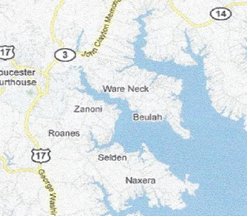
Map
2009
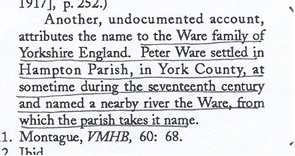
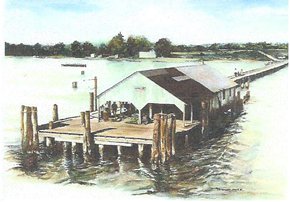
Ware’s
Wharf by: Gigi Vranian Artist rendering of Ware’s Wharf from
a 1915 black and white photograph belonging to Helen and Joe Ware. The original photograph is part of
the ‘Mariners’ Museum collection in Newport News, Virginia.
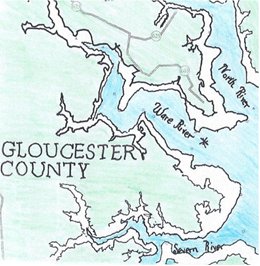 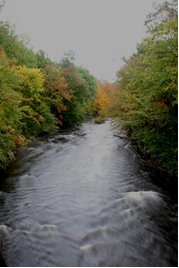
Map
showing Ware River
Ware
River
By 1634, the House of Burgesses had taken the original colony of Jamestown and
subdivided the area into eight shires, later to be known as counties. The ensuing years would find these
counties divided and subdivided many times.
For purposes of this history, it is mainly important to know the
following:
|
FORMATION DATE |
COUNTY |
PARENT COUNTY |
|
1634 |
Henrico County |
(originally called Charles City) |
|
1634 |
York County |
|
|
1642 |
|
Renamed |
|
1648 |
Northumberland County |
|
|
1651 |
Gloucester County |
came out of York |
|
1654 |
New Kent County |
came from York |
|
1691 |
King and Queen County |
formed out of New Kent |
|
1702 |
King William County |
from King and Queen |
|
1721 |
Spotsylvania County |
from Essex, King & Queen, and King
William |
|
1728 |
Goochland County |
formed out of Henrico |
|
1728 |
Caroline County |
Essex, King and Queen, and King William |
|
1734 |
Orange County |
formed out of Spotsylvania |
|
1749 |
Cumberland County |
formed out of Goochland |
It was into these counties that many of our Ware ancestors moved.
(see below)
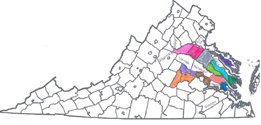
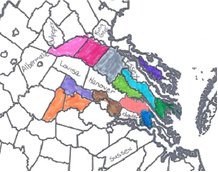
One of the many descendants of James Ware I was Josiah William Ware, a man who
greatly valued family history and often spoke of his roots. He was the cousin of Lucy Ware Hayes,
wife of President Rutherford B. Hayes.
He wrote to Hayes in 1876 that he was
“descended from the Todds of lower
Virginia, where some are known to be our relatives in Caroline County.”
(Ref. 299)
In
1879, during one of Josiah’s many visits to the White House, he provided even
more information for President Hayes.
In discussing his great grandfather, James Ware I, Josiah related,
“the family came from Gloucester County,
Virginia where there is a Ware Church and a Ware River.”
(Ref.289)
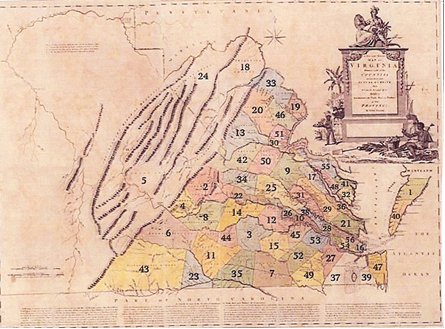
#9 Caroline County #21
Gloucester County #29 King &
Queen Co.
There actually was more than one Ware family that settled in Virginia during
these years, and although not all seem to be connected to the same direct
genealogical line, it would appear that becoming active in church affairs was a
high priority for all of them.
“In 1651, Gloucester County was formed
from York County and divided into 4 parishes:
Abington, Kingston, Petsworth, and
Ware. The King decreed that all newly settled land be
divided into districts headed by a rector. The Wares were Vestrymen in Abington
and Ware Parish before the formation of the county.”
(Ref. 6, 162,379, 388, 851)
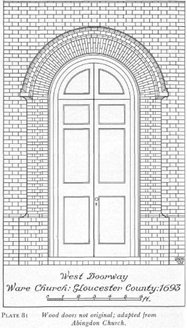
Drawing
of the doorway at Ware Church Gloucester County
1693
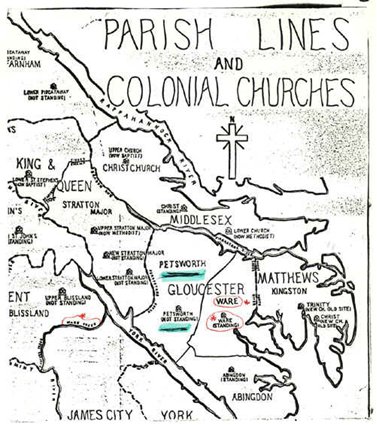
(Ref.
162) Parish
lines and Colonial Churches – notice “Ware” in red
for Ware parish, Ware Standing, and Ware Creek
The years following the birth of James would be defining ones for him
personally, and also for the entire world in which he lived. Map makers would be in high demand as
counties, rivers, caves, and mountains were discovered and explored – not to
mention a new nation that was evolving.
Change was coming and coming fast.
The first rumblings may have very well started in the hallowed halls of
the churches.
|

